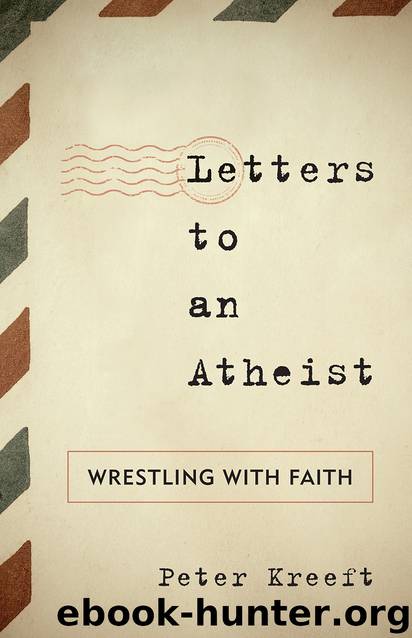Letters to an Atheist by Peter Kreeft

Author:Peter Kreeft
Language: eng
Format: epub
Publisher: Rowman & Littlefield Publishers
Published: 2014-05-09T04:00:00+00:00
26
Dear Michael,
I now see why you so quickly admitted that the God idea was “too good to be true,” even though that involved you in a deep existential problem about the dividedness of the human heart if its two deepest ideals, goodness (God) and truth (reality), lead in opposite directions. You do understand the experience Lewis calls Sehnsucht (longing), and you understand why it leads some people to believe in God.
I would call that “the way of hope,” not “the way of faith,” for faith, though it does not need Clifford’s kind of evidence in order to be rational, does demand some sort of evidence to make the object of faith probable; but hope only needs possibility. You can’t hope for the impossible, but you can hope for the surprising if it is possible, however improbable it may be. And of course the desire in itself is not a proof or even an argument; yet the “argument from desire” does claim to be a proof, and you have not yet refuted it.
You mention Plato’s cave, the most famous image in the history of philosophy. I think you understand why it is so famous because you understand the deep things in the human heart that it appeals to. Unlike most philosophers, who interpret it only as an intellectual theory in metaphysics and epistemology—the objective reality of universals or class concepts, Plato’s “theory of forms” or “theory of (Platonic) Ideas”—you connect it with Sehnsucht, the mysterious longing for something we’ve never had and can’t define. I think you are profoundly right there, even though you think that the world outside the cave is only Plato’s “dream” rather than a reality.
I think you are quite right, and quite profound, in connecting it with heart, love, desire, hope, and so on, rather than merely a theory about ideas (or Ideas). It hits the heart, not just the head. We desperately want there to be a world outside the cave. We want Hamlet to be right when he says, “There are more things in heaven and earth, Horatio, than are dreamed of in your philosophy.” Postmodernist nihilism and its “hermeneutic of suspicion” says there is less.
Perhaps that’s part of the hidden attraction of the fine arts, especially the most “mystical” of them, music. They are “signals of transcendence,” fingers pointing beyond themselves toward exits from the cave. That’s what explains why my students’ favorite argument for God is the argument from the music of Bach, and why I know three ex-atheists (two of them philosophers and one a poet and a monk) who said they were converted away from atheism by Bach’s St. Matthew Passion. It’s not just sentimentalism; it’s an intellectual intuition: the music we have in our soul just has to match the music outside our soul. There has to be more.
Not that it’s not a great cave. But there has to be more. We see this with most conviction not when we are poor and in pain, when the cave is smallest and darkest and most uncomfortable.
Download
This site does not store any files on its server. We only index and link to content provided by other sites. Please contact the content providers to delete copyright contents if any and email us, we'll remove relevant links or contents immediately.
Resisting Happiness by Matthew Kelly(2887)
The Social Psychology of Inequality by Unknown(2310)
Designing Your Life by Bill Burnett(2265)
Day by Elie Wiesel(2242)
The Giving Tree by Shel Silverstein(1837)
Angels of God: The Bible, the Church and the Heavenly Hosts by Mike Aquilina(1628)
Human Design by Chetan Parkyn(1574)
Augustine: Conversions to Confessions by Robin Lane Fox(1473)
The Supreme Gift by Paulo Coelho(1445)
Hostage to the Devil by Malachi Martin(1396)
7 Secrets of Divine Mercy by Vinny Flynn(1392)
Jesus of Nazareth by Joseph Ratzinger(1378)
Dark Mysteries of the Vatican by H. Paul Jeffers(1341)
The Vatican Pimpernel by Brian Fleming(1340)
Saints & Angels by Doreen Virtue(1311)
St. Thomas Aquinas by G. K. Chesterton(1306)
My Daily Catholic Bible, NABRE by Thigpen Edited by Dr. Paul(1207)
Called to Life by Jacques Philippe(1201)
The Ratline by Philippe Sands(1165)
